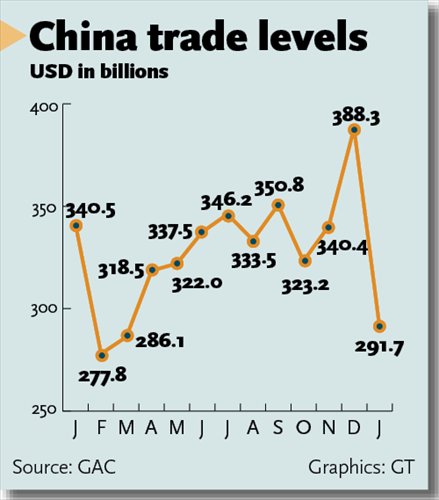Trade pressure predicted to ease in Q2
Private sector gaining larger share of trade, energy imports decrease

People walk in an almost empty shopping mall in Beijing on Monday. Chinese trade slumped in January, authorities said on Monday, as both exports and imports tumbled with feeble domestic and global demand dragging on the world's second-largest economy. Photo: AFP

Graphics: GT
China's downward export pressures are expected to ease in the second quarter this year despite weaker-than-expected January trade data on Monday, the seventh straight month of decline for exports, according to the General Administration of Customs (GAC).
The GAC said that the leading index for China's exports stood at 31.7 in January, the first time it increased from the previous month since February 2015, which signals that downward pressure on China's exports will eventually ease.
January exports in US dollar terms fell 11.2 percent from a year ago, and imports plunged by 18.8 percent, data released by the GAC showed on Monday.
Analysts polled by Reuters had expected January exports to fall 1.9 percent, while imports had been expected to drop only 0.8 percent, following a decline of 1.4 percent and 7.6 percent in December, according to a Reuters report on Monday.
January's trade data shows encouraging signs of the country's economic structural reforms.
Trade involving private companies hit 773.05 billion yuan ($119 billion), up 1.1 percent from 2015, accounting for 41.1 percent of the total, up 4.4 percentage points from the same period last year, read a statement posted on the GAC website Monday.
This compares with weaker trade from foreign-invested companies in China and of State-owned enterprises (SOEs). Exports from foreign-invested companies declined 12.3 percent in January, and SOEs saw a fall of 15.7 percent.
"Small- and medium-sized form the bulk of private companies, and more easily adjust to demanding market conditions," Bai Ming, a research fellow at the Chinese Academy of International Trade and Economic Cooperation, told the Global Times on Monday. "But many key exports, such as high-speed trains and nuclear power plants, can only be carried out by the SOEs."
Zhang Ning, a research fellow with the National Academy of Economic Strategy at the Chinese Academy of Social Sciences, said the performance of private companies in trade is preferred by both the Chinese government and the public.
"The private sector's performance shows greater vitality from last year. In 2015, private companies accounted for 45.2 percent of the country's total exports, surpassing foreign-invested companies."
According to the GAC, exports of products from labor-intensive industries declined, including textiles, costumes, mechanical and electronic products.
Imports of iron ore and refined oils increased in volume, while crude oil, coal and grain imports decreased in January.
"Chinese manufacturers have to find their niche, competing in terms of quality against high-value products from manufacturers such as those from the US and Japan, and competing in terms of costs against low-end products from manufacturers such as those in Vietnam," Bai said.
"Retail sales during the Spring Festival holidays increased by 11.2 percent from last year, which suggests consumption remains stable. And the slump in trade reflects fewer investments, possibly from weaker property investments and measures to reduce overcapacity," Japanese financial company Nomura said in a research note sent to the Global Times Monday.
Experts said January trade generally reflected the growing trend in imports and exports seen in 2015.
China's trade slid by 8 percent in 2015 from 2014 levels, its worst performance since the global financial crisis.
Bai said that a mix of global and domestic factors continue to weigh trade down.
"The economic performance of developed economies such as the US, the Europe, Japan and emerging economies such as Brazil and Russia are all far from encouraging, thus limiting demand," Bai said.
Compared with the same period in 2015, trade in January with the EU, the US and economies of the Association of Southeast Asian Nations declined by more than 14 percent.
Positive outlook
Experts are less optimistic than the government, saying that China's trade performance will continue to be weighed down this year due to low external demand, the yuan's appreciation, rising domestic production costs and the plunge in global commodity prices.
Despite the trend, experts said more government policies are working toward a better and more vigorous business environment in China, and 2016 shows promise.
"Industrial upgrades, urbanization and enhanced living standards will spur imports of more materials and products used in production or as daily consumption goods," Zhang said, adding that exports will be augmented by products and technologies from the strategic emerging sectors and continued growth in e-commerce.
Measures to stabilize trade include the stabilization of the yuan, the further simplification of trade procedures and further synchronizing the nation's initiative to build the overland and maritime Silk Roads in cooperation with other countries and regions, Zhang said.